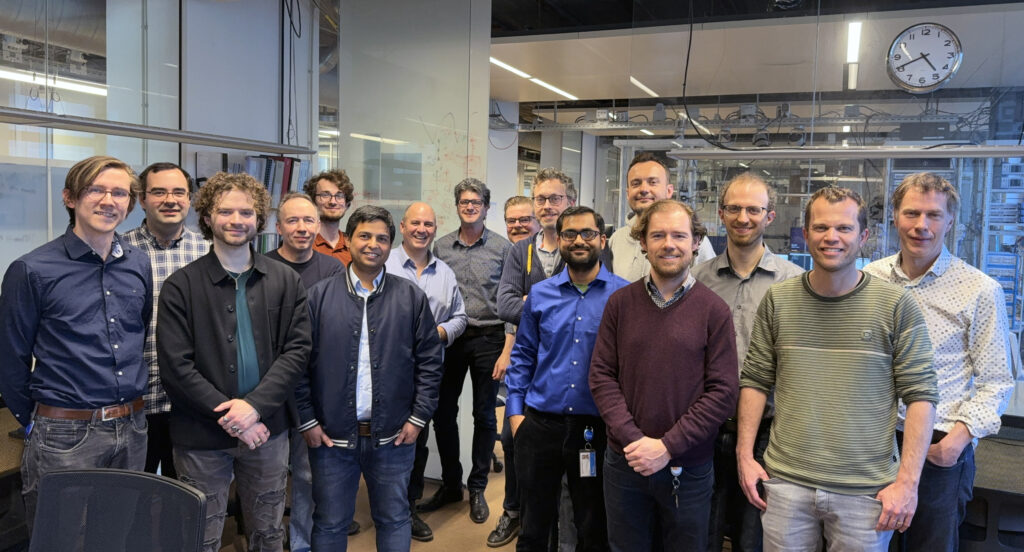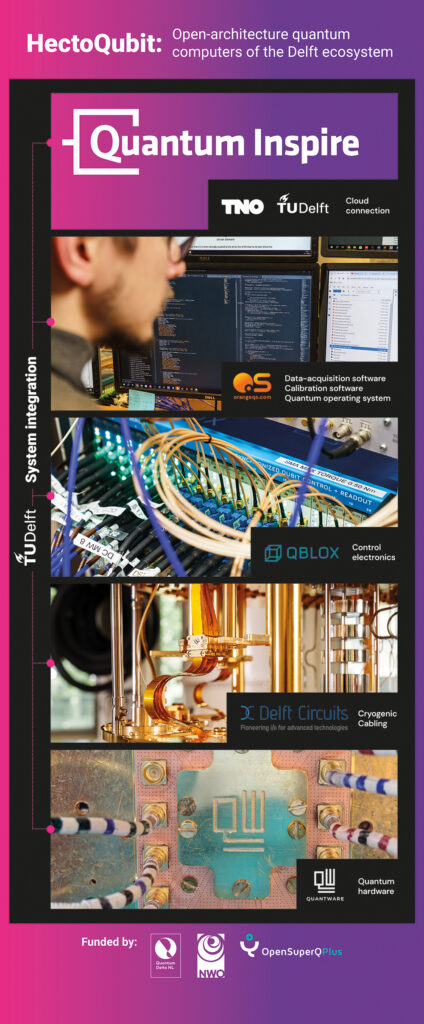15.05.2025Quantum Computing
Delft quantum ecosystem launches open-architecture quantum computer

The Dutch quantum ecosystem has reached a new milestone toward scalable quantum computing with the release of the Tuna-5 system via the Quantum Inspire public cloud platform. Developed within the HectoQubit/2 project—a collaboration between QuTech, TNO, and four Dutch quantum startups (QuantWare, Qblox, Orange Quantum Systems, and Delft Circuits)—Tuna-5 showcases a fully integrated quantum system built using an open-architecture approach and leveraging the Delft quantum supply chain.
Open-architecture: Delft’s distinctive approach to quantum computing
The open-architecture Tuna-5 system integrates interoperable hardware and software components, featuring a superconducting quantum processor with tunable couplers (hence the name “Tuna”), modular control electronics, intuitive quantum toolkits and operating system, a user-friendly public cloud interface, and a Python-based software development kit (SDK). The “open-architecture” approach to building Tuna-5 system, as opposed to the vertically integrated quantum computers available via some leading commercial players, is a distinctive feature of the Delft quantum ecosystem. The open-architecture approach is more than just assembly of quantum hardware and software sourced from various vendors. The extensive testing, iterations, and integration of hardware and software components into a fully-functional Tuna-5 system has helped strengthen the Dutch quantum supply-chain of interoperable quantum components.
Hosted in the DiCarlo lab at QuTech, the Tuna-5 system shows how academic R&D and start-up ventures can partner to create value in the emerging quantum computing market. In the HQ/2 project, research in the DiCarlo lab directly contributed to new and/or improved quantum products and tools of the companies involved. In turn, these tools improve the academic competitiveness and R&D infrastructure of the lab. The collaboration also helps lower the R&D costs for startups, improving market access and creating economic development in the Dutch quantum ecosystem.
National and European synergy for global impact
Launched in April 2023 with funding from Quantum Delta NL and the National Growth Fund, HQ/2 strategically aims to strengthen Dutch leadership in superconducting quantum computing. The efforts in this national project are multiplied by the alignment with OpenSuperQPlus, an EU Quantum Flagship project targeting a 100-qubit quantum computer by September 2026, with Delft as one of three European demonstrator sites.
The release of Tuna-5 follows the February 2025 launch of Quantum Inspire 2.0, which introduced the upgraded Starmon-7 and Spin2+ quantum processors. Quantum Inspire users now have the option to choose from three real quantum hardware backends namely Tuna-5, Starmon-7 and Spin-2+, in addition to the QX-emulator backend. Notably, Tuna-5 builds on the legacy of Starmon-5, deployed in 2020 on Quantum Inspire 1.0. Many of the scientists and engineers behind Starmon-5 have since co-founded and work at the very startups now contributing to HQ/2—bringing the story full circle as academia and entrepreneurship fuse to realize next-generation quantum computers.
Technical innovation through collaborative development
The Tuna-5 quantum processor, fabricated by partner QuantWare features flux tunable qubit couplers. This is a remarkable improvement over the fixed-frequency couplers in the Starmon generation of quantum processors. A “coupler” is a quantum hardware element that mediates the interactions between two qubits and enables performing quantum operations on a qubit pair. While a fixed-frequency coupler as present in the Starmon generation of quantum processors always allows a set amount of interactions, a tunable coupler can be tuned and toggles to control the interaction between qubit pairs helping reduce error in quantum operations.
Each startup contributes a vital and interoperable layer to the quantum computer’s architecture. Qblox delivers the control electronics, QuantWare manufactures the quantum chips, and Orange Quantum Systems provides its proprietary quantum toolkit, including the innovative Orange Juice operating system. Seamlessly connecting this hardware and software ecosystem to the Quantum Inspire cloud is the HQ/2 backend. This sophisticated orchestration layer manages the complex interplay of software communications across the public interface (SDK and web UI) and the intricate workings of the quantum operating system and toolkit. Quantum algorithms, programmed by a user in Python, are translated into precise electromagnetic pulse sequences via the quantum software stack developed by TNO. The Tuna-5 system does not use Delft Circuits’ cryogenic cabling since they are currently integrated in a separate, scaled up prototype of the Tuna system planned for release later this year.
Why this release matters
It’s important to understand that the Tuna-5 system represents a significant system readiness exercise, paving the way for the more powerful and scaled-up quantum computers currently in development within the HQ/2 project. Further advancements and releases are anticipated in the coming months. Additional details about Tuna-5, with contributions from researchers and engineers at TU Delft, QuantWare, and Orange Quantum Systems, are available in a preprint from the DiCarlo Lab, led by Prof. Leo DiCarlo, the scientific coordinator of HQ/2, accessible here: https://arxiv.org/pdf/2503.13225


